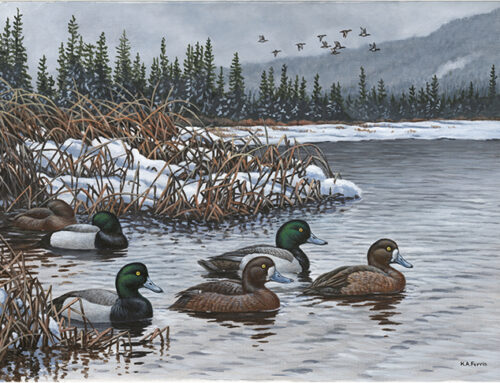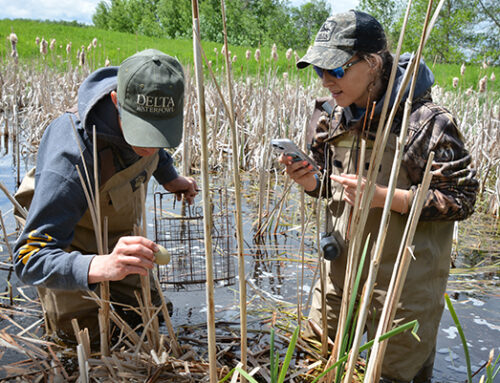USFWS Report: U.S. Duck Hunter Numbers, Duck Harvest Decreased in 2019-2020

How many Americans went waterfowling last season, what states shot the most ducks and what species were most frequently harvested? All that and other intriguing statistics are available in the U.S. Fish and Wildlife Service’s 2020 Migratory Bird Hunting Activity and Harvest report.
U.S. Hunter Numbers Decrease
According to the report, there were 989,500 active waterfowl hunters in the United States last season, down from 1.09 million in 2018-2019. The decline marks the first time since the 2015-2016 season and only the third time in the past 81 years that the number of waterfowl hunters in the United States has dipped below 1 million.
The number of U.S. waterfowlers has steadily declined since reaching a high of 2.03 million in 1970. Delta Waterfowl remains committed to reversing this trend through its HunteR3 programs, which include First Hunt, Defending the Hunt and the University Hunting Program.
Fewer Ducks, More Geese Bagged
Unseasonably mild conditions once again challenged duck hunters across much of the United States last season. The duck harvest of 9.72 million is a decrease from the 10.33 million harvested in 2018-2019.
However, the goose harvest is up slightly, tallying 2.69 million — including 2.07 million Canada geese — compared to the 2.44 million bagged two seasons ago. The harvests of light geese and specklebellies are also up, while fewer brant were shot than two seasons ago.
Mallards continue to be the most commonly harvested species, with 2.9 million taken last season. That’s more than double the second-most harvested species, green-winged teal at 1.17 million. Wood ducks typically rank third on the harvest list, but the 946,838 shot last season are surpassed by the gadwall harvest of 1.05 million. The blue-winged/cinnamon teal harvest (the species are impossible to distinguish during wing surveys) of 802,057 rounds out the Top 5.
The ring-necked duck harvest of 374,088 leads all divers, while the harvests of buffleheads (210,846) and redheads (188,793) rank second and third, respectively.
Flyway Totals
In the Atlantic Flyway, 193,600 waterfowlers bagged 1.24 million ducks and 442,100 geese. North Carolina’s 29,200 active waterfowlers edged Maryland for most hunters in the flyway, and the Tar Heel State’s duck harvest of 232,600 is the most in the East by a large margin. North Carolina’s wood duck harvest of 100,561 is nearly four times its second most-harvested duck, mallards (25,829).
The Mississippi Flyway’s 418,100 waterfowlers shot 4.17 million ducks and 1.02 million geese — by far the largest waterfowl harvest of any flyway. Arkansas was dominant in terms of hunter numbers and duck harvest. The state’s 77,500 active waterfowlers is an increase of more than 15,000 hunters over two seasons ago. Arkansas hunters bagged 1.09 million ducks — just 150,000 shy of the entire Atlantic Flyway — including 509,879 mallards. Louisiana’s 50,100 waterfowlers bagged 572,400 ducks, the second-highest harvest in the flyway. Minnesota had the second-most active waterfowl hunters at 57,700.
In the Central Flyway, 212,800 active waterfowlers harvested 2.11 million ducks and 747,500 geese. With 77,100 active waterfowlers, Texas accounted for nearly one third of the flyway’s hunters. Not surprisingly, Lone Star state hunters also had the flyway’s largest duck harvest, totaling 787,800 birds — including 153,713 blue-winged/cinnamon teal. North Dakota’s duck harvest of 406,900 was the second highest tally in the Central Flyway last season.
Out West, 160,100 Pacific Flyway waterfowlers bagged 2.14 million ducks and 469,800 geese. California had more active waterfowlers (49,000) who harvested more ducks (962,200) than any western state. Additionally, the average California waterfowler shot 21.1 ducks last season — the highest total in the nation. Green-winged teal were the most commonly bagged ducks in California, with a harvest of 288,875. The harvests of mallards (147,680) and wigeon (142,026) also added weight to hunters’ straps.






[…] the number of waterfowl hunters nationwide was on a downward trend. Not good. According to the U.S. Fish and Wildlife Service’s 2020 Migratory Bird Hunting Activity and Harvest Report, the number of active waterfowl hunters dipped below the 1-million mark for only the third time in […]
[…] 2020, there were 989,000 duck hunters in the United […]